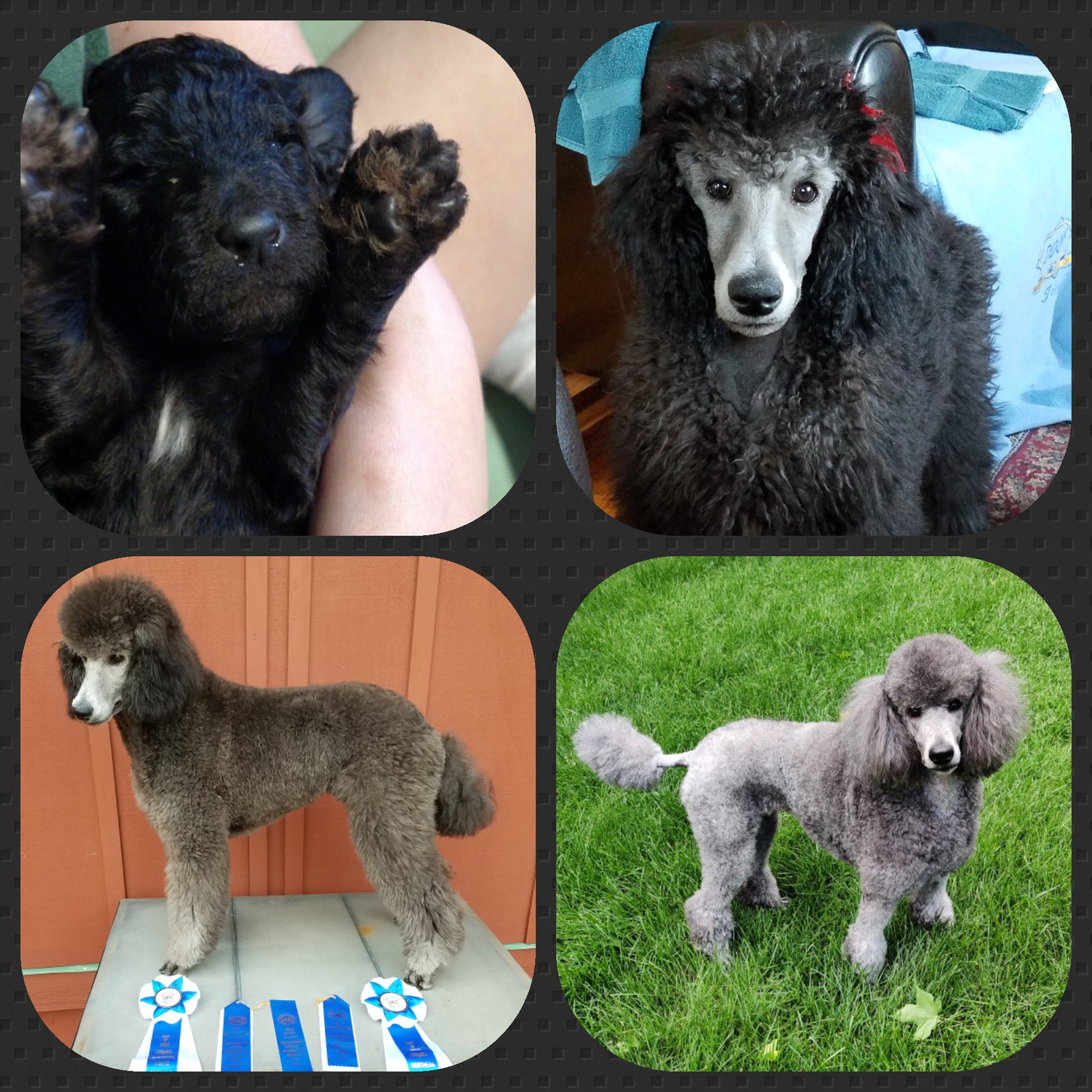Have you ever wondered why black toy poodles can sometimes turn silver? It’s a fascinating phenomenon that occurs in certain poodles, and it has captured the curiosity of many dog enthusiasts. While most people are familiar with black poodles, their transformation into a stunning silver color can come as a surprise.
When it comes to black toy poodles turning silver, there are several factors at play. In the world of poodles, their hair color can change over time due to a process called progressive greying. This means that as a black toy poodle ages, their coat may fade and transition to a silvery-gray hue. This can happen gradually or sometimes more rapidly, giving them a unique and beautiful appearance.
Black toy poodles can indeed turn silver as they age. This is due to a gene called the “silvering gene” that affects the poodle’s coat color. As black toy poodles get older, their fur may gradually lighten and develop a silver hue. However, it’s important to note that not all black toy poodles will turn silver. The presence of the silvering gene varies among individuals. If you have a black toy poodle, it’s possible that their coat may turn silver over time.

The Color Transformation of Black Toy Poodles
Toy Poodles are one of the most popular dog breeds known for their intelligence, elegance, and overall cuteness. While the breed standard for Toy Poodles is predominantly focused on solid coat colors such as black, white, apricot, and red, it is not uncommon for their coat color to change over time. One particular question that often arises is whether black toy poodles turn silver. In this article, we will explore this intriguing topic and shed light on the color transformation process of black toy poodles.
Understanding the Genetics of Toy Poodle Coat Colors
In order to understand why black toy poodles may turn silver, it is important to have a basic understanding of the genetics behind their coat colors. The coat color of a toy poodle is determined by a combination of genes inherited from its parents. Specifically, the melanin pigment produced by cells called melanocytes in the hair follicles plays a crucial role in determining coat color.
In the case of black toy poodles, their coat color is primarily determined by the presence of a dominant black gene. This gene suppresses the expression of other coat color genes, resulting in a solid black coat. However, there are other genes that can influence the expression of the black gene, leading to a potential color change in the coat.
The Silvering Process in Black Toy Poodles
As black toy poodles age, the melanocytes in their hair follicles may start to produce less melanin pigment. This reduction in pigment production can result in a gradual color change in the coat, often referred to as “silvering.” The silvering process typically starts around the muzzle and face, and then gradually spreads throughout the body over time.
During the silvering process, the black pigment in the coat fades, and the individual hairs take on a lighter shade, ranging from silver to gray. This transformation can be quite distinct, giving the appearance of a different coat color altogether. It is important to note that not all black toy poodles will undergo this silvering process, as it is dependent on various factors including genetics and individual differences.
Factors Influencing the Silvering Process
While the gradual color change from black to silver is a natural aging process for some black toy poodles, there are several factors that can influence the speed and extent of the silvering process:
- Genetics: Some black toy poodles may have a genetic predisposition to silvering, while others may not.
- Health and diet: The overall health and nutrition of a poodle can impact the condition of its coat and potentially affect the silvering process.
Other Coat Color Changes in Toy Poodles
In addition to black toy poodles turning silver, there are other possible coat color changes that can occur in this breed:
1. Brown to silver: Brown toy poodles may also undergo a similar silvering process, resulting in a silver or gray coat.
2. Black to blue: Some black toy poodles may experience a color change from black to a bluish-gray shade, known as “blue” in poodle terminology.
3. Apricot to red: Apricot toy poodles may darken in color as they mature, eventually resulting in a rich red shade.
Caring for the Coat of a Silver Toy Poodle
When a black toy poodle turns silver, proper coat care becomes crucial to maintain its health and appearance:
1. Regular grooming: Brushing the coat regularly helps prevent matting and keeps the silver hairs looking their best.
2. Sun protection: Limiting sun exposure and using dog-safe sunscreen can help prevent further fading of the silver coat.
3. Professional grooming: Regular visits to a professional groomer can ensure that the coat is properly trimmed and styled to enhance the silver color.
Conclusion
While black toy poodles typically have a solid black coat, it is possible for them to undergo a natural color transformation and turn silver. The silvering process occurs as the melanocytes in the hair follicles reduce their pigment production, resulting in a gradual change from black to silver or gray. Various factors can influence the speed and extent of the silvering process, including genetics, health, diet, and UV exposure. It is important to provide proper coat care for a silver toy poodle to maintain its health and appearance.
Table 1: Possible Coat Color Changes in Toy Poodles
| Original Coat Color | Possible Color Change |
| Black | Silver or Blue |
| Brown | Silver |
| Apricot | Red |
Key Takeaways: Do Black Toy Poodles Turn Silver?
1. Some black toy poodles may develop a silver coat as they age.
2. The process of a black toy poodle turning silver is called “progressive graying.”
3. Not all black toy poodles will turn silver; it depends on their genetics.
4. Silver toy poodles have a unique coloration that is sought after by some dog enthusiasts.
5. Silver toy poodles still belong to the toy poodle breed, but they have a different coat color.
Frequently Asked Questions
Here are some common questions and answers about black toy poodles and whether they turn silver:
1. Why do some black toy poodles turn silver?
Black toy poodles can sometimes develop a silver coat as they age. This is due to a gene called the “silvering gene” which affects the pigmentation of their fur. It is a natural process and not a cause for concern.
The silvering gene can cause the black coat to fade over time, resulting in a silver or gray appearance. This typically occurs gradually and may not be noticeable until the poodle is several years old. However, not all black toy poodles will turn silver as it depends on their genetic makeup.
2. Can you predict if a black toy poodle will turn silver?
Predicting whether a black toy poodle will turn silver is not always possible. While the presence of the silvering gene increases the likelihood, it is not a guarantee. Some poodles may carry the gene but never show any silvering, while others may start developing a silver coat at a young age.
If you are considering getting a black toy poodle and are concerned about the possibility of it turning silver, it’s best to speak with a reputable breeder who can provide information on the dog’s lineage and any known genetic traits.
3. Is a silver toy poodle the same as a black toy poodle that turned silver?
No, a silver toy poodle is not the same as a black toy poodle that turned silver. Silver toy poodles are a recognized color variation in the breed and are born with a silver coat. They have a different genetic makeup compared to black toy poodles and do not experience the gradual silvering process.
If you specifically want a silver toy poodle, it’s important to find a reputable breeder who specializes in breeding this color variation.
4. Can the silvering gene be passed down to future generations?
Yes, the silvering gene can be passed down from black toy poodles that turn silver to their offspring. If a silver toy poodle is bred with a black toy poodle that carries the silvering gene, there is a chance that some of the puppies in the litter may also develop a silver coat.
However, if both parents are black toy poodles without the silvering gene, it is unlikely that any of their offspring will turn silver.
5. How can I care for a black toy poodle that turns silver?
Caring for a black toy poodle that turns silver is similar to caring for any other poodle. It is important to maintain a regular grooming routine, including brushing their coat to prevent matting and keeping their ears clean to prevent infections.
In addition, since silver toy poodles may have a different coat texture compared to black toy poodles, it’s important to use appropriate grooming products and techniques specifically designed for their coat type.

Do Poodle Puppies Change Color: How to Predict Your Poodle’s Adult Coat Color
In summary, black toy poodles do have the potential to turn silver as they age.
This change in color occurs due to a process called “progressive graying.”
